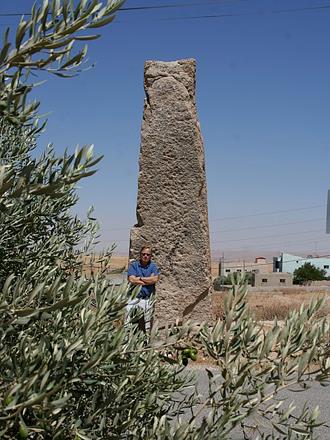
Jordan's Neolithic Mysteries: Ceremonial Menhirs' Ritual Functions
Scholars have been speculating that menhirs were also used as territorial markers due to their anthropomorphic figures and symbols, associated with lost ceremonies and shrines.
Located south of Wadi Rum, Khirbet Rizkeh is a ritual site excavated in the 1960's by British archaeologist Diana Kirkbride, who discovered huge monoliths dating from the Late Neolithic period.
“Archaeologists define a 'ceremonial landscape' as a group of stone and/or earthworks constructed on a scale large enough to effectively create a landscape,” noted Stephen Savage from Columbian College of Arts and Sciences, adding that the best known example of a ceremonial landscape is Stonehenge, with its great circle of standing stones surrounded by earthworks.
Menhirs belong to structures that represent a ceremonial landscape as they are associated with ritual and mortuary activities, sacrificial rituals or astronomical functions.
“The ceremonial landscapes of Chalcolithic and Early Bronze Age Jordan is unique in the Near East, although it bears a striking resemblance with Western Europe and the British Isles during a similar period,” claimed Savage, adding that for that reason, early travellers to Jordan were impressed by the thousands of dolmens (prehistoric monuments of two or more upright stones supporting a horizontal stone slab, which may have functioned as tombs or sites of primary interment prior to secondary burial elsewhere), menhirs, stone circles and alignments.
Savage, who spent over 30 years studying stone structures in the Levant, draws other parallels:“New methods of archaeological analysis have been used to study the relationship between menhirs and their natural settings, in hopes of helping to determine how these enigmatic structures functioned.”
Analysis of menhirs sites in Jordan indicates that they share some common traits: Hillside terrace locations where large megalithic stones are readily available, Savage underlined, adding that enough menhirs and dolmens contained skeletal remains to suggest that“these structures in Jordan are the normal form for disposal of the dead of a large part of the population over a long period”.
Although there are some doubts on the basis of the low number of Early Bronze habitation sites compared with dolmens as a population of this size is beyond the carrying capacity of the region in the Early Bronze Age, Savage stated that“twenty thousand dolmens built over a period of four hundred years means only fifty a year, which does not seem to require a large population”.
It is also possible that dolmens were used as temporary burial places. The ones at Bab edh-Dhra“contain many secondary burials: Interments where the body is first buried elsewhere, with the bones being bundled together and placed in a secondary location for permanent burial”.
Unfortunately, dolmen study fields are threatened by urban expansion, as well as by stone and gravel quarries.

Legal Disclaimer:
MENAFN provides the
information “as is” without warranty of any kind. We do not accept
any responsibility or liability for the accuracy, content, images,
videos, licenses, completeness, legality, or reliability of the information
contained in this article. If you have any complaints or copyright
issues related to this article, kindly contact the provider above.

















Comments
No comment